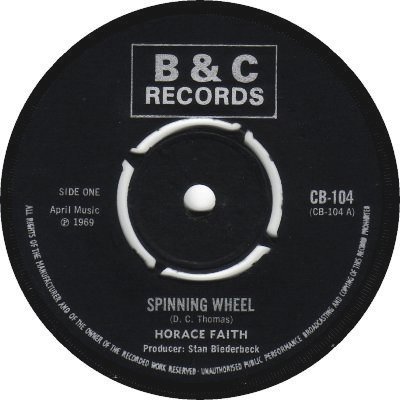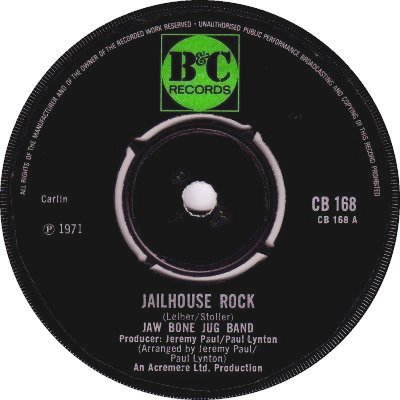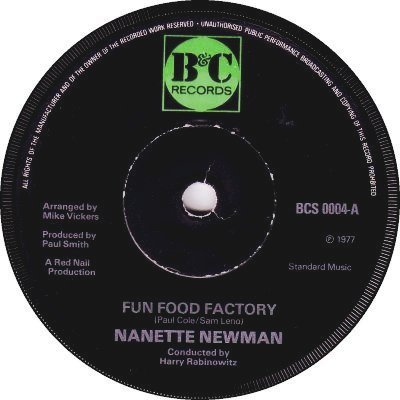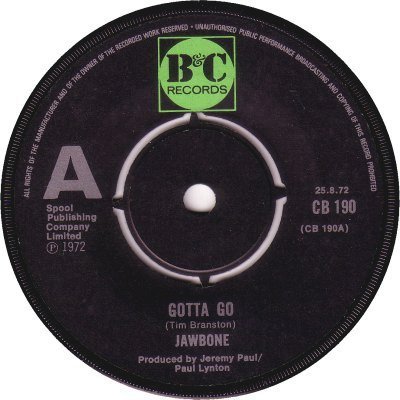




The roots of B&C Records lie in Beat & Commercial Records, a company set up in 1963 by Lee Gopthal in association with Chris Blackwell and David Betteridge of Island Records. Initially Beat & Commercial concentrated on selling records to retailers, but in the mid '60s it established its own collection of retail outlets. Island enjoyed considerable success licensing and issuing Reggae records, and Gopthal followed their example; he formed B&C Records Ltd in 1968 and quickly established a small group of labels including Amalgamated, Tabernacle, John Abbey's 'Action' (q.v. all), and the '60s-only Stable. 1968 also saw the revival of the Trojan (q.v.) label, which Island had started in 1967 with no great success; this time it was to be a shared venture between Island and B&C. Trojan and B&C remained closely linked for the best part of the next eight years. Another company with strong links to B&C was Charisma (q.v.), which was formed towards the end of 1969; indeed the two were so close that they shared catalogue numbers.
B&C first saw the light of day as a label in 1969. Billboard of the 15th March of that year claimed that Action intended to launch a Country label called 'Big Wheel' and had signed Merrill E. Moore to record for it, but it never materialized; when the actual B&C label made its debut, however, in May of that year, its first single was by Moore. 'Music Week' of the 2nd of April 1969 reporting on the birth of B&C said, somewhat puzzlingly, that its parent company had been called 'Action-Stable' but was changing its name to B&C Records. According to the report the first B&C single was to be released the following week, and product would continue to be issued on both Action and Stable. 'MW' of the 15th of August 1970 commented that B&C had been 'successful', and added that the company saw itself as primarily a marketer, mainly of independent productions; at that point B&C was being aimed at the 'commercial Pop' market, with Action handling the R&B output. According to the report, distribution of its records was by Island and Philips / Phonodisc at that point, with manufacture being handled mainly by Orlake. Shortly afterwards (19th August) 'MW' revealed that EMI was to take over manufacture with effect from the 1st of September. 1971 saw the advent of a 'progressive' offshoot, 'Pegasus', which ran into trademark problems and had to be renamed 'Peg' within a few months (q.v. both).
B&C had initially enjoyed a close relationship with Island and had shared the same building, but the two gradually grew apart. July 1972 saw the end of B&C's distribution agreement with that company, and talk of a possible amalgamation with Charisma; from the start of that month EMI was to be responsible for distribution as well as for pressing ('MW', 1st July). Then in October Island relinquished its share of Trojan, leaving the label under B&C's sole ownership, and a short while later it moved to new premises. Change was in the air: B&C saw itself increasingly as a marketing concern, and it phased out its B&C and Peg labels, which were replaced in the spring of 1973 with Mooncrest (q.v.), a joint venture with Charisma ('MW', 3rd April). B&C extended its sales force and continued solely as a marketing company for the Charisma, Trojan and Mooncrest labels. A Soul label linked to Trojan, 'People', came on the scene in July 1973, and in 1974 an American label, Sussex, joined the B&C family under a distribution agreement (q.v. both). Sadly, there was trouble looming. Charisma severed its ties with B&C in the summer of 1975, and shortly afterwards B&C ran into severe financial difficulties. Its assets were transferred to two new companies with names that were very similar to the old ones, B&C Recordings Limited and Trojan Recordings Limited. These new companies were sold to Marcel Rodd's 'Art & Sound Ltd.', the parent company of Saga Records ('MW', 14th June), and the old B&C and Trojan went into liquidation ('MW', 28th June) - 'crashed' was the word used by Billboard. Under its new owners the Trojan label continued, and the B&C label itself reappeared in late 1976 for a mixture of Pop and Reggae products. It continued to release singles until 1980, albeit sporadically.
In its first incarnation B&C's singles shared a joint CB-100 series with those of Charisma, the first Charisma release being CB-116. The first five B & C releases came in a black label with silver printing (1); from CB-105 onwards the silver box at the top was replaced by the more familiar green logo (2). Demo copies had a medium-sized solid silver 'A' and the date (5). The 'silver box' single shown above was a Pye pressing, as opposed to the usual Orlakes of the period. Singles from the Saga years were initially numbered in the BCS-0000s and were distributed by Selecta (3); two records in that series appeared on the Lightning label, and one on Punk (q.v. both). The only two that I have seen in the vinyl seem to be Saga's own pressings. Saga had another go at reviving B&C from 1979-80; singles from this era were numbered in the BCS-00s, and were distributed first by WEA and then by CBS. The first of them BCS-16, had a silver logo rather than a green one (4); in the '80s the colour scheme changed to red on white. As far as the music on offer was concerned, B&C provided a wide range from Folk and Soul through MOR Pop and Rock 'n' Roll to straight-ahead Rock; two of its singles by (The) Arnold Corns have a David Bowie connection. It managed to reach the Singles Chart just three times: once with The Weathermen ('It's The Same Old Song' b/w 'Why Should I Fight'; CB-139, 12/70) and twice with Atomic Rooster ('Tomorrow Night' b/w 'Play The Game'; CB-131, 5/70, and 'Devil's Answer' b/w 'The Rock'; CB-157, 6/71). Most of the gaps in the discography below are Charisma releases. Mark Jones's 'The B&C Discography: 1968-75', available via Google Books, provides a detailed history of what was evidently a complex and convoluted operation. Thanks to James Denholm for the fourth scan.



Copyright 2006 Robert Lyons.

